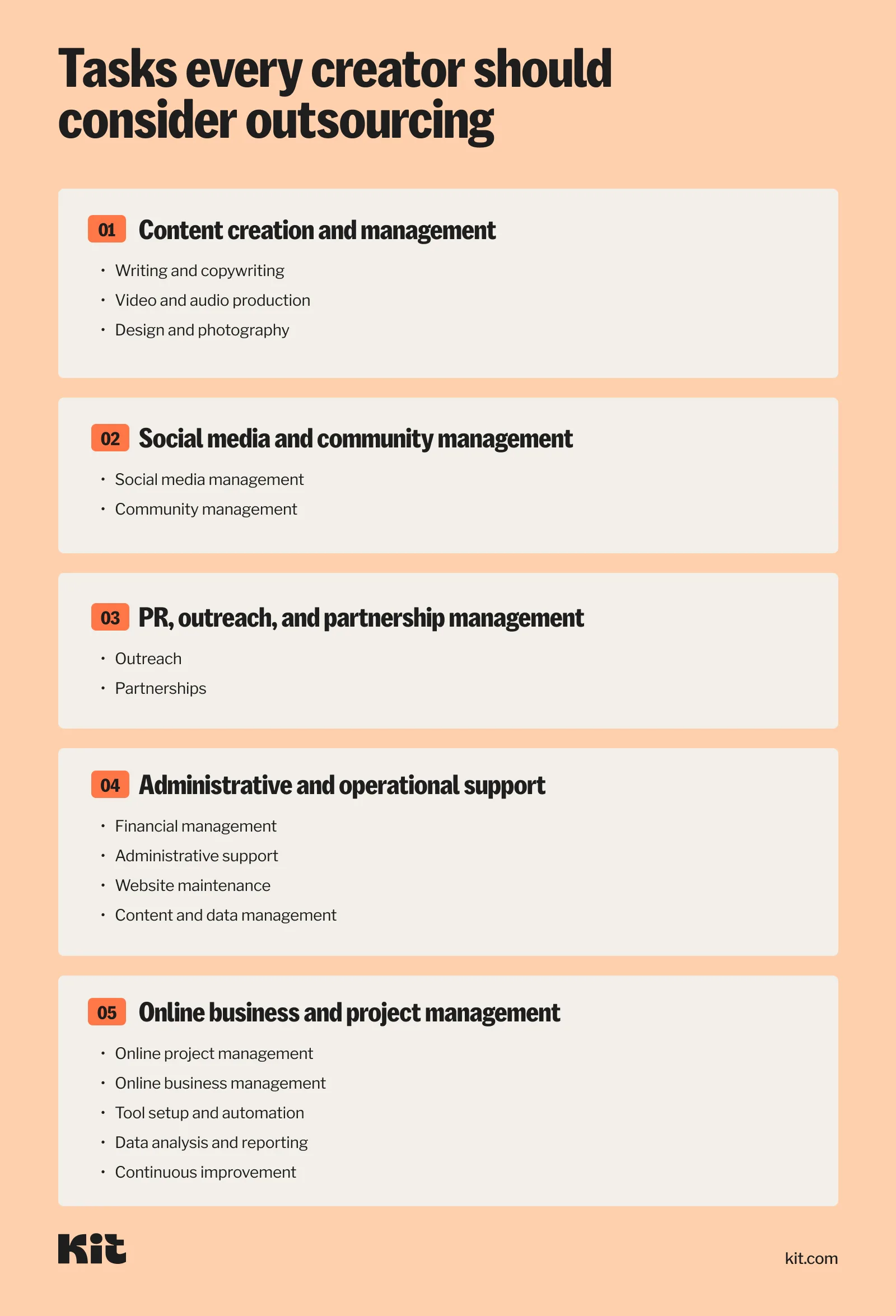In this Article
Having a virtual assistant on your team might be what you need to grow your business.
From handling admin tasks to keeping your inbox under control, outsourcing to virtual assistants can help streamline your workflow and keep things running smoothly.
What is a virtual assistant?
Virtual assistants (VAs) are remote workers you hire to help with specific tasks for your business. They aren’t in-house employees working solely for your business. Instead, think of VAs as contractors or professional service providers who you hire to work on an hourly or retainer basis.
What can you outsource to a virtual assistant?
You can outsource nearly any task to a VA.
A common misconception is that VAs are like executive assistants who only help with admin tasks. But VAs offer a range of services, and there’s a good chance you can find help regardless of your task.
However, creators often find it difficult to pass off tasks to someone else. After all, this is your business. You created it and feel a sense of connection to each and every task within it (even the tasks that don’t light you up).
Designer (and Kit’s very own Creative Director) Charli Marie says she was worried outsourcing would make her content less ‘hers.’ So, she asked herself these three questions to find what she could never let go of:
- What do I love doing most?
- What things can only be done by me?
- What would be inauthentic if it were done by someone else?
Answering these questions inched her closer to uncovering which tasks she’d be ok parting with. And they can help you determine the same.
Still unsure? Let’s explore popular tasks VAs often help creators with.

Content creation and management
- Writing and copywriting: Blog posts, case studies, website copy, product descriptions, ad copy, social media captions, YouTube descriptions, script writing, email marketing content, creating lead magnets or opt-in incentives
- Video and audio production: Podcast production, repurposing content, creating teaser clips and intros and outros, creating and managing video or podcast series, editing videos and podcasts, video transcription, subtitles, voiceovers, creating and managing video ads or promotional videos
- Design and photography: Graphic design, product photography, image editing, creating custom illustrations or infographics, designing marketing materials (e.g., brochures, banners, etc.)
Social media and community management
- Social media management: Content creation, scheduling, engagement, responding to messages and interacting with followers, running paid social media ads, reviewing analytics, conducting social media audits and strategy adjustments
- Community management: Overseeing online communities and engagement, moderating forums or discussion groups
PR, outreach, and partnership management
- Outreach: Finding press opportunities, pitching to publications, podcasts, and speaking engagements, creating and managing press kits
- Partnerships: Managing sponsors and affiliate partnerships, coordinating joint ventures or collaborative projects
Administrative and operational support
- Financial management: Invoicing and follow-up, accounts payables, bookkeeping, financial forecasting and budgeting
- Administrative support: Scheduling meetings, managing emails, customer email triage, managing CRM systems and customer onboarding
- Website maintenance: Website management, updating content, performing regular website backups and security checks
- Content and data management: Uploading and managing emails, videos, and course materials, collecting analytics, conducting A/B testing, and analyzing results for optimization
Online business and project management
- Online project management: Coordinating projects, managing timelines, team communication, implementing project management frameworks or methodologies
- Online business management: Overseeing online operations, team management, SOPs, strategic planning and business process mapping
- Tool setup and automation: Setting up and automating digital business tools, integrating systems, setting up advanced automation workflows for customer journeys
- Data analysis and reporting: Analyzing data, generating reports, optimizing processes, creating custom dashboards for data visualization
- Continuous improvement: Identifying and implementing process improvements and new technologies, conducting competitive analysis and industry benchmarking
How much do virtual assistant services cost?
The cost of virtual assistant services varies between countries, industries, and level of expertise. However, to get an idea, we can turn to Upwork, which found that VAs charge anywhere from $12/hour for tasks like data entry to $50+/hour for web development and consulting.
These rate ranges tell us one thing: there’s a good chance you’ll find a VA within your budget.
Signs that you’re ready to outsource tasks and grow your business
Some days, you might feel like you have enough time to get everything done. But other days leave you exhausted and feeling worn down.
So, when is it time to hire help?
- You want to buy more time for revenue-generating work: Want to increase revenue but don’t have the time for money-making tasks? Outsourcing can take non-revenue tasks off your plate so you have more time for activities you can directly tie a dollar to.
- You lack expertise in certain areas: What might take you eight hours to figure out could take an expert VA only one. VAs let you work in your area of genius, so you don’t need to worry about taking on the role of a developer/designer/accountant/videographer (etc.) if you don’t want to.
- You need to focus on big-picture goals: You can’t focus on strategies that tie directly to long-term goals, like product creation or cold pitching new clients, when you’re worried about a ballooning inbox or which hashtags to use on your next Instagram post. If you’re sidetracked with time-sucking tasks, it’s time to ask a VA for help.
- You want to avoid burnout: Creator burnout can sneak up on you and often happens when you feel overworked and can’t separate your personal life from your business. A proactive approach is best. If you feel burnout creeping in, you likely need to adjust your workload and ease the burden by outsourcing to a VA.
Where can you find a virtual assistant?
Virtual assistants aren’t hard to find. Still, it takes some digging to find one that’s right for you.
Join specialized forums and Facebook groups
Groups and forums are meant to connect VAs with possible clients.
Have a look at the following ones to see if there’s a good match for your business and its needs.
- The Virtual Assistant subreddit
- Facebook groups:
Post a job on freelancing platforms and websites
Virtual assistants hang out on Fiverr, Virtual Gurus, and UpWork. Simply make a post or job request listing your requirements and wait for VAs to apply.
Tap into your network
You already have an audience that knows what you do and who you serve—so why not lean on these folks to find someone? Here are some ideas:
- Reach out to your email list: You might have VAs signed up for your list who are already familiar with you and your business. They’ll be able to get up and running right away with minimal onboarding from you.
- Ask your social media followers: Your social followers also know who you are and what you do. They can either sign up for the job or refer you to the right person.
- Get referrals from other creators: Use Kit’s Creator Network to connect with creators. Some may be VAs themselves, while others may know of reputable folks to help you out.
More ideas
- Run searches on Google, LinkedIn, and X/Twitter: Search engines and social platforms are excellent ways to expand your pool of options. Start by defining the roles of people that could help you with your tasks. For example: graphic designer, video editor, and virtual assistant. Then, add ‘VA’ or ‘virtual assistant’ to narrow your search.
- Hire a customer: Your past customers already know your products and services, making it easier for them to get up to speed on the rest of your business. Your potential hire might be a long-time course student or a former client.
- Use matchmaking services: Matchmaking services ask questions about the tasks you’re looking to delegate, the skills and qualities you’re looking for, your budget, and other details so they can suggest the VA that fits the bill. Some VA matchmaking services include Great Assistants, and Virtual Assistant Finder by Fully Booked VA.
- Hire an approved Kit expert: We’ve done the hard work and found some of the best VAs around. All you need to do is pick the right one for your business. Our vetted list of experts are ready to help you with things like tech, automation, and scaling.

6 tips for effective outsourcing and delegation
1. Be prepared to give more feedback early on
When you first work with a contractor, it’s normal to take some time for the process to become seamless for you and them.
You’ll likely share quite a bit of feedback in the beginning, but the clearer your feedback early on, the better your contractors will work.
Charli described her experience after providing lots of feedback to her editors:
They quickly picked up on what I liked and didn’t. So if you outsource something and don’t initially feel like it saved you a lot of time, stick with it a while, and it should get faster the more you both ease into the process (and if it doesn’t, maybe it’s time to try someone else).
Plus, be receptive and open to feedback from your VA. They’ve likely worked with other clients like you and may have tips to help things chug along smoothly.
This initial extra time you’re spending with a new hire is what creator Khe Hy calls the J-Curve, a term borrowed from the world of investing.

The J-Curve in financial investing. Image via RadReads.
You start “in the red” because you invest some time in training and setting up processes, but that investment pays for itself quickly because the hire saves you time in the long run.
Your VAs will appreciate your patience as the two of you learn how to best work together.
2. Start small
Outsourcing doesn’t have to be a massive endeavor that clears your schedule and transforms every step of every process in your business. It’s ok to get help with small tasks, like inbox management, while you get your footing.
Starting small lets you minimize the risk while still reaping the benefits of delegating tasks you don’t want to do, aren’t great at, and don’t have time for.
Benjamin Houy of French Together recommends giving it a try, even if you’re not sure.
There’s very little risk, and working with fellow creators can be life-changing. It helped me create much better content and focus on my true strengths.
Start by outsourcing just a couple of tasks or with a small number of contractor hours per week. Notice how that makes you feel and tweak your approach accordingly.
3. Be clear about your expectations
Effective outsourcing leaves no room for vague job descriptions. Be as clear as you can from the first assignment, and you’ll make your ongoing relationship with your contractor better.
Creator Andrea Bizzotto recommends you document tasks and requirements upfront, as this will reduce interactions needed until the job can be considered done. He adds:
For the first assignment I outsourced, I created a detailed design spec outlining what I wanted. Then, I trusted my hire to do all the magic and produce a great result. Now when I need a banner, I just send a low-fi concept of what I have in mind, wait for the first delivery, provide some feedback, and get the final result.
4. Establish a workflow and a hub for work
Instead of relying on back-and-forth emails, set up a central place you and your contractors can refer to for files, checklists, and all project and task details.
Choosing tool(s) is less important—go with whatever is practical for you and your contractor.
Use your tool of choice to define tasks and due dates and any dependencies between tasks. It’s also a great place to store written or video walkthroughs of certain processes, which helps with reusing these resources if you hire more contractors.
5. Create guidelines
If you’re worried your contractor won’t be able to replicate your work (like your tone of voice or visual style), creating comprehensive guidelines will help.
Benjamin shared his own process:
My main worry before outsourcing was that the creators wouldn’t understand French Together’s learning philosophy and brand, so I spent a few hours writing a style guide, as well as a guide explaining what the blog stands for and who our audience is. This made a huge difference.
Based on what you’re outsourcing, your guidelines can include details such as:
- Phrases and words your audience uses (and doesn’t use)
- Desired tone of voice with scenario examples
- Colors and imagery that resonate with your brand
- Questions and pain points your audience struggles with
6. Be legally sound
Finally, make sure you’re always on firm legal ground. Never hire without a contract, and always make sure all terms are clearly outlined, including (but not limited to):
- Length of your agreement
- Services your contractor will provide you
- Payment terms, including rates, responsibilities around expenses, and invoicing process
- Considerations around late fees, delayed payments, and taxes
- Confidentiality
- Cancellation and dispute terms
- Renewals
Your contractor might have a standard contract they use, but you can also put your own contract in place. You can find free templates online, or purchase a specific template that matches your situation.
Streamline your business with a VA, freelancer, or contractor
Handing off tasks to someone else can feel intimidating at first, especially when you’re used to doing everything by yourself, but VAs, like Kit’s Experts, will put those fears at ease—you might even wish you hired help sooner!






